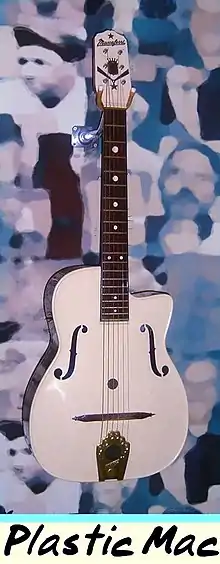Mario Maccaferri | |
|---|---|
| Born | 20 May 1900 |
| Died | 17 April 1993 (aged 92) |
| Nationality | Italian |
| Occupation(s) | Inventor, Luthier, Guitarist |
| Known for | Designing the Selmer guitar |
Mario Maccaferri (1900–1993) was an Italian luthier, classical guitarist, businessman, and inventor.[1] He is noted for designing the guitar favored by jazz musician Django Reinhardt, and for designing plastic clothespins, plastic bath and kitchen tiles and the plastic Islander ukulele which sold millions of copies in the mid-1900s. From 1939 he lived and worked in the United States. As of 2016 his daughter Elaine still runs the family company French American Reeds Inc.[2]
Early life
Maccaferri was born in Cento, Emilia-Romagna. At the age of 11 he was apprenticed to luthier Luigi Mozzani and took up the classical guitar. By 1923 he had established a reputation as a player and maker of classical guitars.[3]
Musical career
In 1933, Maccaferri injured his right hand in a swimming pool accident, ending his career as a concert performer, though he continued to work as a luthier and inventor.[3]
Lutherie designs
Maccaferri is best-known for designing the Selmer Maccaferri guitar played by Gypsy jazz legend Django Reinhardt.[4] His design featured the distinctive “D-shaped” sound hole. Maccferri's innovations extended to materials as well: he was an early adopter of laminate backs and sides for guitars, and for instruments made entirely of plastic.
Plastic instruments

In 1941, Maccaferri patented a plastic woodwind reed, in 1947 he patented two plastic clothespin designs, and in 1949 he launched his line of plastic "Islander" ukuleles in collaboration with television star Arthur Godfrey, which would sell into the millions of units.[5] Maccaferri also developed the Chord Master, an automatic chording device originally designed for the ukulele.[6] In the 1950s, Maccaferri produced a line of plastic guitars, but they had little commercial success.[7][8] Later in his career and up until his death, Maccaferri worked on the design for a plastic violin, which in 1990 was used at a performance at Carnegie Hall.[9][10]
References
- ↑ From Maestro to Mastro: The Life, Music, and Instruments of Mario Maccaferri. University of Memphis. 2008. ISBN 978-1-109-07389-8.
- ↑ "History". Frenchamericanreeds.com. Retrieved 27 December 2016.
- 1 2 Stewart Button (November 2005). Julian Bream: The Foundations of a Musical Career. Bold Strummer Limited. pp. 62–. ISBN 978-1-57784-067-1.
- ↑ Wright, Michael (20 June 2014). "Maccaferri History | Vintage GuitarÂŽ magazine". Vintageguitar.com. Retrieved 27 December 2016.
- ↑ Dave Hunter (15 May 2013). 365 Guitars, Amps & Effects You Must Play: The Most Sublime, Bizarre and Outrageous Gear Ever. Voyageur Press. pp. 46–. ISBN 978-0-7603-4366-1.
- ↑ "Plastic Fantastic: How Mario Maccaferri Revolutionized the Uke Scene". Ukulele Magazine. 27 July 2015. Retrieved 11 July 2022.
- ↑ "Maccaferri Guitars". National Music Museum. Retrieved 27 December 2016.
- ↑ Tony Bacon (12 October 2012). The Ultimate Guitar Sourcebook. Race Point Publishing. pp. 65–. ISBN 978-1-937994-04-4.
- ↑ Experimental Musical Instruments. Experimental Musical Instruments. 1996.
- ↑ Maurice J. Summerfield (June 1998). The jazz guitar: its evolution, players and personalities since 1900. Ashley Mark. ISBN 978-1-872639-26-0.